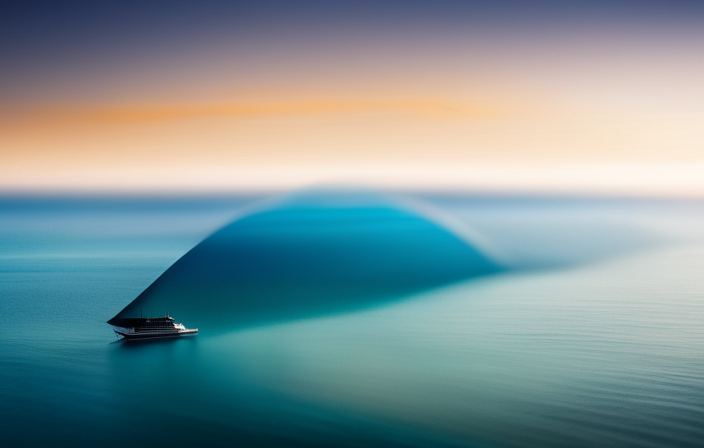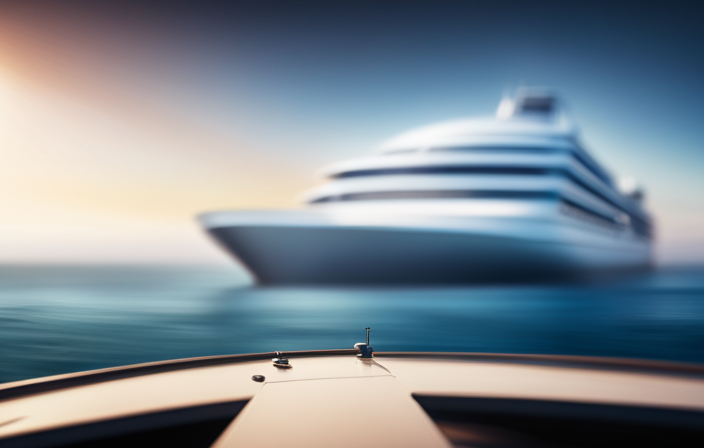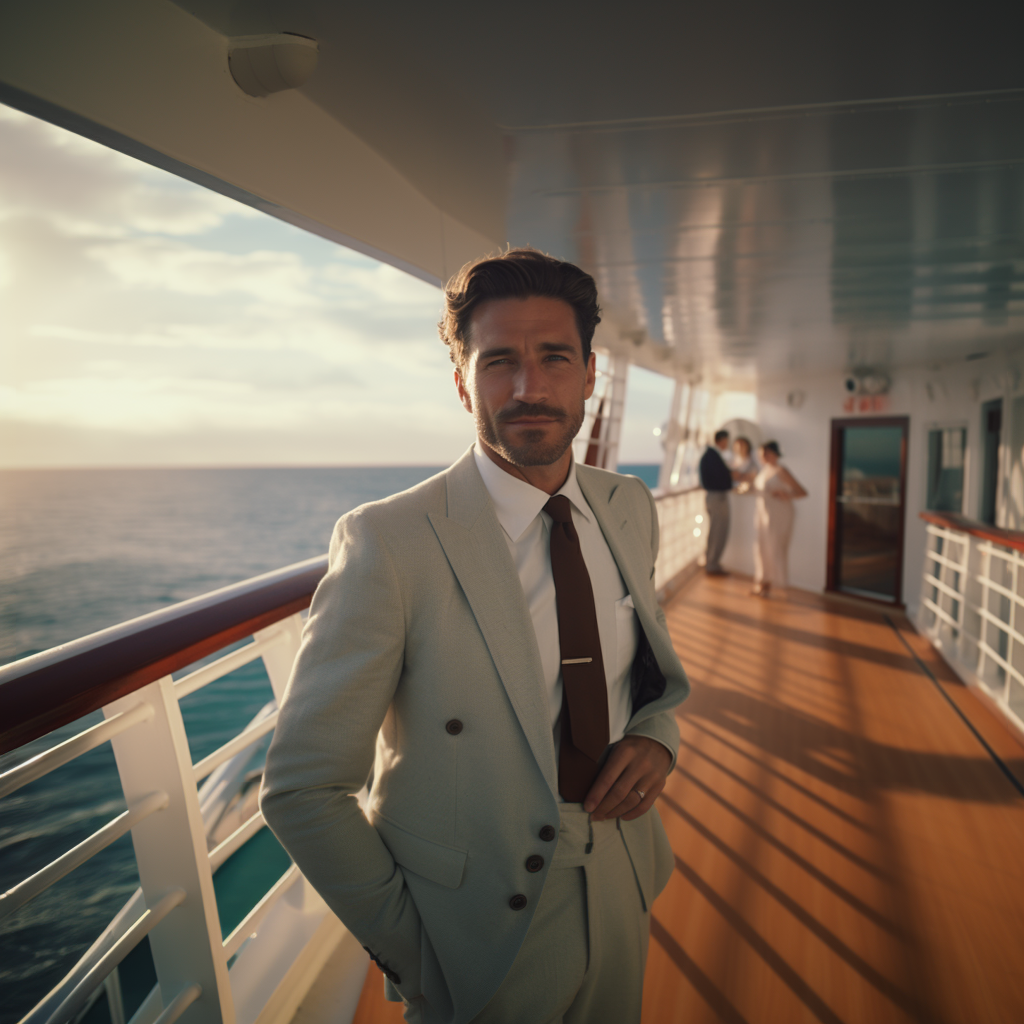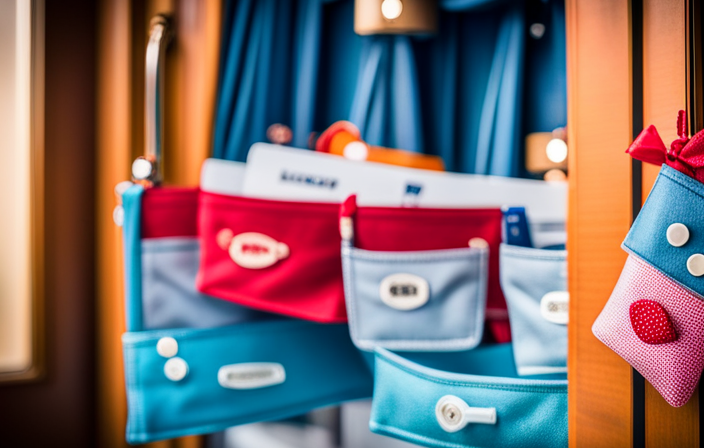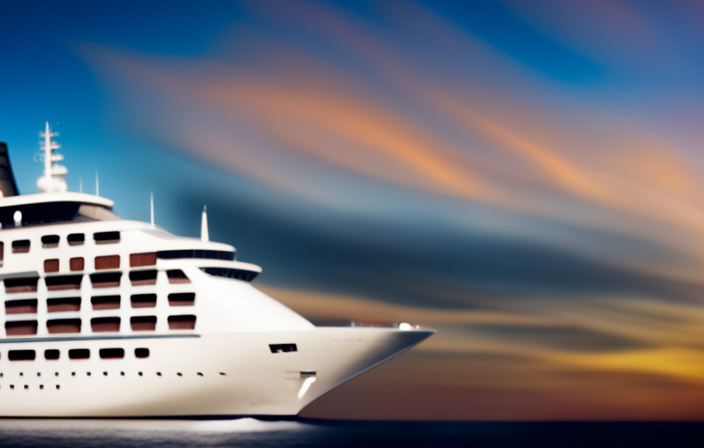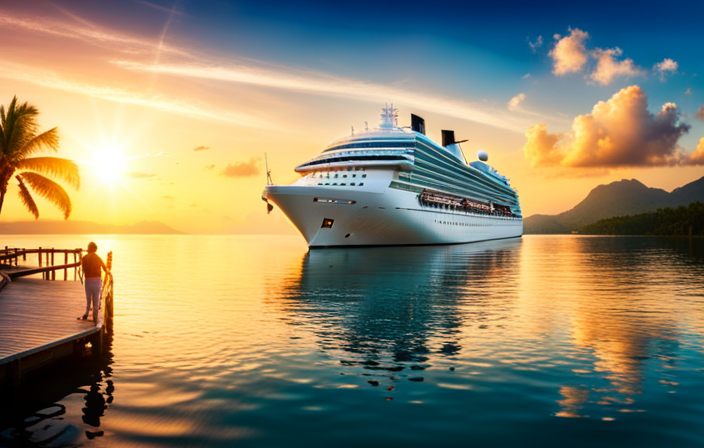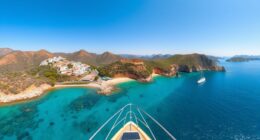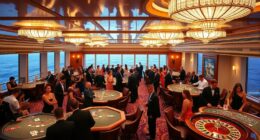Picture yourself facing an expansive ocean that unfolds like a boundless avenue of opportunities. While aboard a majestic cruise ship, I am amazed by the extraordinary voyages this vessel can embark on within a single day.
Cruise ships are like modern marvels of engineering, capable of traversing vast expanses of water with ease. In this article, we will explore the question: how far can a cruise ship travel in a day?
We will delve into the factors that determine a cruise ship’s range, the longest distance ever traveled by a cruise ship, and popular cruise routes and distances. We will also discuss the technological advancements and innovations that have revolutionized cruise ship travel, as well as the trade-offs between speed and comfort.
So, buckle up and get ready for a fascinating journey into the world of cruise ship travel.
Key Takeaways
- Cruise lines strive to balance speed and safety in order to maintain a comfortable ride for passengers.
- Weather conditions can impact travel speed, affecting the duration between ports and the number of port visits.
- Advancements in shipbuilding technology, such as advanced propulsion systems and optimized hull designs, have increased cruise ship fuel efficiency and allowed for longer travel distances.
- Climate change, including melting ice caps and rising sea levels, may open new routes and enable exploration of diverse and remote destinations.
Cruise Ship Speed and Distance
Cruise ships can cover impressive distances in just one day, allowing passengers to experience the thrill of exploring multiple destinations in a short amount of time. The speed at which a cruise ship can travel greatly impacts the distance it can cover in a given day.
On average, a cruise ship travels at a speed of 20 knots, which is equivalent to around 23 miles per hour. With this speed, a cruise ship can cover approximately 480 nautical miles in a 24-hour period.
However, it’s important to note that the actual distance traveled by a cruise ship in a day can vary depending on factors such as weather conditions, currents, and the ship’s size and design. These factors determine a cruise ship’s range and will be discussed in the subsequent section.
Factors that Determine a Cruise Ship’s Range
Imagine being on board a magnificent vessel, gliding through the open waters. Have you ever wondered what determines the impressive range of such a majestic floating palace? The range of a cruise ship is influenced by several factors, including its fuel efficiency and the impact of weather conditions. Fuel efficiency plays a crucial role in determining how far a cruise ship can travel in a day. The design of the ship’s hull, the type of engines used, and the weight of the vessel all contribute to its fuel consumption. Additionally, weather conditions such as wind speed and direction can affect the ship’s range. Strong headwinds can significantly reduce a cruise ship’s speed and increase fuel consumption. Taking these factors into account, cruise ship operators carefully plan their routes to optimize fuel efficiency and maximize the ship’s range. Understanding these factors allows us to appreciate the incredible distances that cruise ships can cover in a single day. Transitioning to the next section, let’s explore the longest distance ever traveled by a cruise ship.
Longest Distance Traveled by a Cruise Ship
Sailing across vast oceans, the longest distance ever covered by a cruise ship was a remarkable feat of maritime exploration.
The cruise ship, named the MV World Odyssey, traveled a staggering distance of 161,000 nautical miles in a single journey. This incredible achievement was made possible by the ship’s impressive travel speed of 22 knots, allowing it to swiftly navigate through the open waters.
The MV World Odyssey’s long-distance voyage spanned several continents and encompassed various popular cruise routes, including the Pacific Ocean, Atlantic Ocean, and Indian Ocean. It showcased the cruise ship’s exceptional endurance and capability to traverse great distances.
As we delve into the subsequent section about popular cruise routes and distances, we will explore the fascinating itineraries that have captivated travelers around the world.
Popular Cruise Routes and Distances
Popular cruise routes and distances vary depending on the destination. Caribbean cruises are known for their turquoise waters and tropical islands. Cruise ships often sail between the islands, making stops at popular ports such as Jamaica and the Bahamas.
Mediterranean cruises, on the other hand, offer a cultural journey through historic cities like Rome and Athens. The distances on these cruises can range from short hops to longer voyages, depending on the specific itinerary.
Transatlantic crossings, on the other hand, are iconic journeys that traverse the vast Atlantic Ocean. These cruises take passengers from one continent to another, with distances that can span thousands of miles.
Caribbean Cruises
Caribbean cruises offer passengers a chance to explore popular Caribbean cruise ports such as Cozumel, Grand Cayman, and Puerto Rico. These itineraries often include stops at multiple islands, allowing travelers to experience the unique culture, cuisine, and natural wonders of each destination.
From relaxing on pristine beaches to exploring historic sites and indulging in thrilling water activities, Caribbean cruises offer something for everyone.
As we transition into the subsequent section about Mediterranean cruises, it’s fascinating to compare the distances covered and the different experiences that await travelers in this equally enchanting region.
Mediterranean Cruises
Nestled amidst a tapestry of ancient wonders and sun-kissed shores, the Mediterranean beckons with its allure of hidden treasures and captivating adventures. Mediterranean cruise itineraries offer a diverse range of options, allowing passengers to explore the rich history and culture of this enchanting region.
From the bustling streets of Barcelona to the romantic canals of Venice, popular ports of call in the Mediterranean promise unforgettable experiences. Whether it’s the vibrant nightlife of Ibiza or the breathtaking beauty of Santorini, each stop along the way offers a unique glimpse into the Mediterranean’s allure.
As we transition into the next section about transatlantic crossings, it’s important to note that the Mediterranean is just the beginning of the journey, with even more exciting destinations awaiting those who embark on a cruise across the vast Atlantic Ocean.
Transatlantic Crossings
After discussing the Mediterranean cruises, it is intriguing to delve into the realm of transatlantic crossings, which are a completely different experience.
Transatlantic cruise ships, also known as transatlantic ocean liners, are designed to withstand the vastness of the open ocean and provide passengers with a smooth and comfortable journey across the Atlantic. These ships are built with advanced navigational systems and powerful engines that enable them to travel long distances at impressive speeds.
With an average speed of 22 knots, a transatlantic ocean liner can cover a distance of approximately 520 nautical miles in a day. This means that it would take around 5 days for a transatlantic cruise ship to travel from New York to Southampton, a distance of approximately 2,600 nautical miles.
Moving forward, let’s explore the fascinating technology and innovations that have revolutionized cruise ship travel.
Technology and Innovations in Cruise Ship Travel
Cruise ship technology and innovations have revolutionized travel, allowing for incredible distances to be covered in a single day. With recent technology advancements, cruise ships are now equipped with state-of-the-art engines that enable them to reach impressive speeds, allowing for greater distances to be traveled in less time.
Additionally, sustainable cruising has become a key focus for cruise ship companies. They have implemented energy-efficient systems, such as LED lighting and advanced waste management systems, reducing their environmental impact.
Moreover, the introduction of advanced navigation systems and satellite communication technology has improved safety and efficiency on board. These innovations have not only enhanced the overall cruise experience but have also made it possible for cruise ships to travel longer distances in a shorter amount of time.
Looking ahead, it is important to consider the fuel consumption and environmental impact of these technological advancements.
Fuel Consumption and Environmental Impact
To lessen the environmental impact of your voyage, it’s crucial to consider the fuel consumption and its consequences.
Fuel efficiency is a key factor in determining the carbon footprint of a cruise ship. The amount of fuel consumed by a ship directly affects its emissions of greenhouse gases, such as carbon dioxide.
Cruise lines have been investing in technologies and practices to improve fuel efficiency, including the use of advanced propulsion systems, optimized hull designs, and energy-saving measures onboard. These measures not only reduce the environmental impact but also result in cost savings for the cruise industry.
As we delve into the next section about cruise ship travel speed vs. comfort, it is important to note that fuel efficiency plays a significant role in balancing these two aspects.
Cruise Ship Travel Speed vs. Comfort
Finding the perfect balance between speed and comfort onboard a cruise can make all the difference in creating an unforgettable and exhilarating experience. When it comes to cruise ship travel speed, passenger satisfaction is a crucial factor.
Cruise lines aim to provide a smooth and enjoyable journey, and the speed at which the ship travels plays a significant role in achieving this.
Firstly, a higher travel speed allows passengers to reach their destination in a shorter time, maximizing the time spent at each port of call.
Secondly, a faster cruise ship can navigate through rough weather conditions more efficiently, reducing the impact of choppy seas and ensuring a comfortable ride for passengers.
Lastly, faster speeds provide a sense of excitement and adventure, as passengers can enjoy the sensation of gliding across the water at a brisk pace.
Considering the impact of weather on cruise ship travel speed, it is important for cruise lines to strike a balance between speed and safety. The subsequent section will explore the relationship between cruise ship travel time and port visits, shedding light on how these factors are interconnected.
Cruise Ship Travel Time vs. Port Visits
In my previous discussion on cruise ship travel speed vs. comfort, we explored how cruise ships balance their velocity with passenger comfort.
Now, let’s delve into the relationship between cruise ship travel time and port visits.
Cruise ship travel time refers to the duration taken by a ship to travel from one port to another. This time is influenced by factors such as distance, weather conditions, and the ship’s speed.
Longer travel times may result in fewer port visits, as the ship needs more time to reach its destinations. On the other hand, shorter travel times allow for more port visits, maximizing the opportunities for passengers to explore various destinations.
Understanding the correlation between cruise ship travel time and port visits is essential for both cruise operators and travelers.
With this understanding, we can now transition to the next section, which discusses future trends in cruise ship travel distances.
Future Trends in Cruise Ship Travel Distances
As cruise ship travel continues to evolve, passengers can anticipate exciting advancements in the distances covered by these floating resorts. Future trends in cruise ship travel distances indicate that ships will be able to travel even greater distances in a single day.
This is made possible by advancements in shipbuilding technology, such as more efficient engines and streamlined designs. Additionally, the impact of climate change on cruise ship travel distances cannot be ignored. As ice caps continue to melt and sea levels rise, previously inaccessible routes may become navigable, allowing cruise ships to explore new territories.
These changes in travel distances will undoubtedly enhance the overall cruise ship experience, offering passengers the opportunity to visit more diverse and remote destinations.
In the next section, we will discuss tips for maximizing your cruise ship travel experience without missing a beat.
Tips for Maximizing Your Cruise Ship Travel Experience
Maximize your cruise ship experience by exploring hidden gems and immersing yourself in unique cultures along the way. To make the most of your time onboard, consider these tips:
-
Engage in onboard activities: Participate in sports tournaments, attend enriching workshops, or indulge in spa treatments to ensure a fulfilling experience.
-
Dine at specialty restaurants: Savor a variety of cuisines at the ship’s specialty restaurants, offering a delectable array of options to suit every palate.
-
Try the main dining room: Experience fine dining at the ship’s main dining room, where an extensive menu awaits you every evening.
-
Take advantage of room service: Enjoy a quiet meal in your cabin by ordering from the room service menu, available 24/7.
By maximizing onboard activities and exploring the diverse dining options, you can create unforgettable memories during your cruise ship journey.
Frequently Asked Questions
What are some popular destinations for cruise ships and their distances from major ports?
Popular destinations for cruise ships include the Caribbean, Mediterranean, and Alaska. These destinations offer a range of experiences and are located at varying distances from major ports, allowing for diverse itineraries and travel options.
How does the size of a cruise ship affect its speed and distance traveled in a day?
The size of a cruise ship has a direct impact on its speed and distance traveled in a day. Larger ships tend to have lower speeds due to their increased mass and drag, resulting in a reduced range of travel.
Are there any regulations in place to control the environmental impact of cruise ship fuel consumption?
Cruise ship regulations to control environmental impact are a joke. They fail to address the significant fuel consumption and emissions of these massive vessels. It’s a technical and analytical failure, lacking precision and effectiveness.
How do cruise ship itineraries balance the need for travel time with the desire for port visits?
Cruise ship itineraries carefully balance travel time and port visits, taking into account fuel consumption regulations. By optimizing routes and speeds, cruise lines aim to maximize passenger experiences while minimizing environmental impact.
What are some emerging technologies or innovations that are expected to increase the distance a cruise ship can travel in a day in the future?
Emerging technologies and future innovations in cruise ship design are expected to significantly increase the distance a ship can travel in a day. These advancements may include improved propulsion systems, lightweight materials, and streamlined hull designs.
Conclusion
In conclusion, the range of a cruise ship’s travel in a day depends on various factors such as its speed, fuel capacity, and weather conditions.
While some ships can cover hundreds of nautical miles, the longest distance traveled by a cruise ship remains an impressive feat.
As technology continues to advance, we can expect innovations that will further expand the boundaries of cruise ship travel.
With careful planning and an adventurous spirit, you can maximize your cruise ship experience and embark on a voyage that feels like sailing to the ends of the Earth.
Alfons is the visionary leader and driving force behind Voyager Info’s success. As the Editor in Chief, he brings a wealth of experience and an unwavering passion for travel to the helm of our cruise-centric platform.
With a lifelong fascination for exploring new horizons, Alfons discovered his love for the ocean and cruising at a young age. From sailing across pristine Caribbean waters to embarking on daring expeditions to far-flung destinations, he has amassed a treasure trove of first-hand experiences in the world of cruising.

